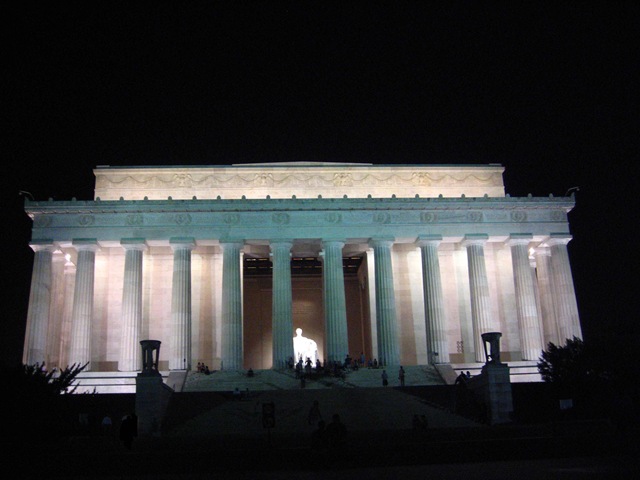
The Lincoln Memorial is an American memorial built to honor the 16th President of the United States, Abraham Lincoln. It is located on the National Mall in Washington, D.C. and was dedicated on May 30, 1922. The architect was Henry Bacon, the sculptor of the main statue (Abraham Lincoln, 1920) was Daniel Chester French, and the painter of the interior murals was Jules Guerin. It is one of several monuments built to honor an American president.
The building is in the form of a Greek Doric temple and contains a large seated sculpture of Abraham Lincoln and inscriptions of two well-known speeches by Lincoln. The memorial has been the site of many famous speeches, including Martin Luther King's "I Have a Dream" speech, delivered on August 28, 1963 during the rally at the end of the March on Washington for Jobs and Freedom.
Like other monuments on the National Mall – including the nearby Vietnam Veterans Memorial, Korean War Veterans Memorial, and National World War II Memorial – the memorial is administered by the National Park Service under its National Mall and Memorial Parks group. It has been listed on the National Register of Historic Places since October 15, 1966. It is open to the public 24 hours a day. In 2007, it was ranked seventh on the List of America's Favorite Architecture by the American Institute of Architects.
The Lincoln Memorial, designed after the temples of ancient Greece, is significant as America's foremost memorial to her 16th president, as a totally original example of neoclassical architecture, and as the formal terminus to the extended National Mall in accordance with the McMillan Plan for the monumental core of Washington.
Abraham Lincoln has long stood in the minds of the American people as a symbol of honesty, integrity, and humanity. Although a national monument to him was not raised until the 20th century, demands for a fitting memorial had been voiced since the time of his death. In 1867, Congress heeded these demands and passed the first of many bills incorporating a commission to erect a monument to Lincoln. An American, Clarke Mills, was chosen to design the structure. His plans reflected the bombastic nationalistic spirit of the age. His design called for a 70-foot (21 m) structure adorned with six equestrian and 31 pedestrian statues of colossal proportions, crowned by a 12-foot (3.7 m) statue of Lincoln. However, subscriptions for the project were insufficient and its future collapsed.
The matter lay dormant until the turn of the century, when, under the leadership of Senator Shelby M. Cullom of Illinois, six separate bills were introduced to Congress for the incorporation of a new memorial commission. The first five bills, proposed in the years 1901, 1902, and 1908, met with defeat; however, the final bill (Senate Bill 9449), introduced on December 13, 1910, passed. The Lincoln Memorial Commission had its first meeting the following year and President William H. Taft was chosen as president. Progress continued at a steady pace and by 1913 Congress had approved of the Commission's choice of design and location. However, this approval was far from unanimous. Many thought that architect Henry Bacon's Greek temple design was far too ostentatious for a man of Lincoln's humble character. Instead they proposed a simple log cabin shrine. The site too did not go unopposed. The recently reclaimed land in West Potomac Park was seen by many to be either too swampy or too inaccessible. Other sites, such as Union Station, were put forth. The Commission stood firm in its recommendation though, feeling that the Potomac Park location, situation on the Washington Monument-Capitol axis, overlooking the Potomac River and surrounded by open land, was an ideal site. Furthermore, the Potomac Park site had already been designated in the McMillan Plan of 1901 to be the location of a future monument comparable to that of the Washington Monument.

With Congressional approval and a $300,000 allocation, the project got underway. On February 12, 1914, an inauspicious dedication ceremony was conducted and following month the actual construction began. Work progressed steadily according to schedule. However a few changes did have to be made. The statue of Lincoln, originally designed to be 10 feet (3.0 m) tall, was later enlarged to 19 feet (5.8 m) to prevent it from being dwarfed by its huge chamber. As late as 1920, the decision was made to substitute an open portal for the bronze and glass grille which was to have guarded the entrance. Despite these changes, the Memorial was finished on schedule. In a May Day celebration in 1922, Commission president William H. Taft dedicated the Memorial and presented it to President Warren G. Harding, who accepted it for the American people.
The Memorial was listed on the National Register of Historic Places on October 15, 1966 lincoln memorial world tour
lincoln memorial world tour lincoln memorial at day
lincoln memorial at day lincoln memorial at night.
lincoln memorial at night. washington dc lincoln memorial
washington dc lincoln memorial
No comments:
Post a Comment